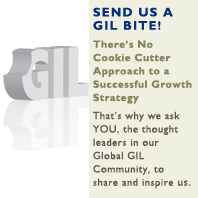| |
 |
|
May 2010 | Vol. 3 Issue 5 |
 |
CONNECT |
 |
 |
 |
 |
|
|
 
POINT OF VIEW
Four Ways to Manage a Diverse
Workforce for Innovation and Growth
 |
|
Which firms comes to mind when you think of innovative organizations? Apple? 3M? What about innovative people? Leonardo da Vinci? Albert Einstein?
Apple has influenced the way people interact with information and media. Einstein changed the way we think about the nature of the universe. These are two very different contributions to the world.
So, what do these innovative organizations and people have in common? One shared characteristic (we realize there are more) is that they see things differently. In some cases, it’s an innate ability to see unique patterns that others do not. In other cases, they may see things differently because they (either as organizations or individuals) take the time to reflect and ask questions that others do not. This was certainly true of Einstein and his thought experiment, “What would happen if I rode on a sunbeam out into the universe?”
At its core, innovation is about introducing something new. Latin experts recognize that the word innovation originates from the root novus, meaning new. But innovation is not just about being different or new, is it? Dennis Rodman, the flamboyant professional basketball player from the 1980s and 1990s was “different,” but if he hadn't been uniquely skilled and successful, he would have simply been considered another unconventional, eccentric character.
So, how do you see something new and take this vision from idea to execution, ultimately generating growth for an organization? We would like to propose four ways to innovate … and fuel your strength-diverse workforce for success.
1) Process improvements: These are actions that your organization takes in order to do things better. When you are continually looking for efficiencies, small changes begin to add up. This makes it necessary for your competitors to continually play catch up. Who, in your organization, always seems to find a better way to get things done? Make sure this person has input into your operations.
2) Organizational culture: Are there new attitudes, beliefs and experiences that could help you achieve your goals? What if you ran a bookstore in which all of the employees were voracious readers themselves
— not just cashiers? What if you managed a chain of coffee shops whose workers knew where the coffee beans were grown, and how the regional soil affected the subtleties of taste? Who, in your organization, understands the importance of these shared attitudes and experiences? And how can this person help you create, communicate and sustain these critical elements for your success and the success of your stakeholders?
3) Customer experience: What are the customer needs — or changes to your customers’ experiences
— that will drive your growth? Who, in your organization, takes time and effort to discover who your customers are and thinks of their plans, needs and expectations? Who asks questions of your customers that no one else thinks to ask? Make sure this person has input into product development and marketing.
4) Vision: What about the difference you want to make in the world? Some would call this a vision. Is there a new direction you want to set for your industry? Do you want to be like another organization? (For example, some say Stanford aspired to be the “Harvard of the West”.) This is where your dreamers and creative-types can help. What could be? What aspirations do you have? What if there were no economic barriers? What's the best possible situation you could imagine for the future of your firm…and the world?
Depending on the strength of your organization, it will probably be stronger in one area of innovation than another. For example, no one would expect a small accounting firm to radically change the way the world works (the way big companies like Apple or 3M have). However, perhaps such a firm could create a new, solution-oriented technology or cutting-edge process.
New ways of doing things – innovations — that foster growth can occur in many disciplines within your organization. You can ask probing questions and promote new ways of thinking within operations, HR, customer service, and at the strategic level. The key is to make sure that both the questions and the answers support what you stand for.
|
|
| |

|
|
|
 |
 |
DON’T FORGET,
GIL IS GLOBAL!
We hope to see you at the following event:

|
 |
 |
GIL 2010: Silicon Valley
The Global Community of Growth, Innovation and Leadership
September 12-14, 2010 |
San Jose, California

|
 |
|
|
|
|
|
|
|
|
|
|
|
|
|
|
|
|
|
|
|
|
|
|
|
|
|
|
|
|
|
|
|
PRIVACY POLICY: We are committed to protecting your right to privacy. © 2010 Frost & Sullivan
This message was sent to you by Frost & Sullivan, 7550 IH 10 W, Ste. 400, San Antonio, TX 78229. If you would prefer not to receive further messages from this sender, please click here or reply to this email and place the word REMOVE in the subject line.
|
|
{OPENEDEMAILMARKER} |
|











